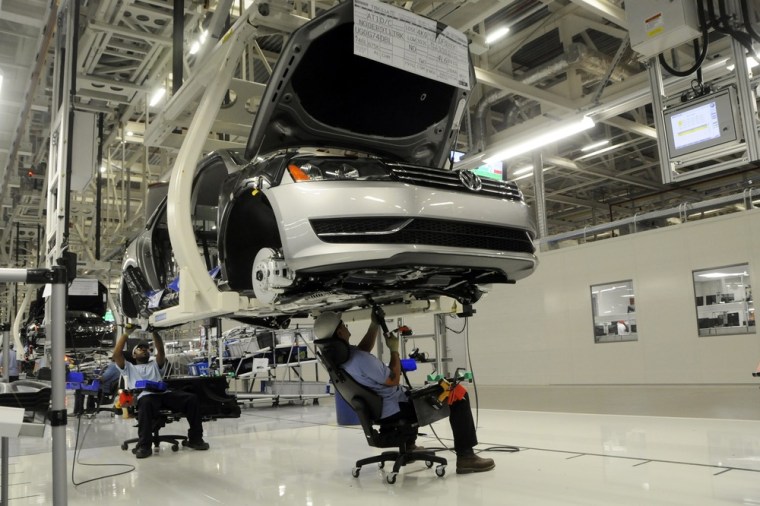After a quarter-century absence, Volkswagen officially began producing cars in the U.S. again this week. The $1 billion operation, in Chattanooga, Tenn., is expected to roll out about 150,000 copies of the German maker’s new Passat sedan by the time it gets fully up to speed next year.
The factory is intended to serve as a lynchpin in Volkswagen’s goal of more than doubling long-stagnant U.S. sales. That, in turn, could help the maker achieve its even more ambitious target of becoming the world’s largest auto manufacturer by decade’s end.
"The Volkswagen Group has finally arrived as a local manufacturer in the United States,” proclaimed Martin Winterkorn, CEO of Volkswagen AG and the man who finally gave the go-ahead to build the new plant.
In the years leading up to the first energy shock of the 1970s, VW was the brand name most likely to come to mind when someone mentioned imports. The original Beetle outsold all its competitors and at one point helped the German maker capture a 7 percent share of the U.S. market.
Aiming to challenge even the domestic makers, VW opened up a plant in Westmoreland, Pa., and began preparing a second factory in suburban Detroit. But the twin oil shocks of the '70s, rather than boosting demand for Volkswagen, opened the door for its Asian rivals. Demand began to slump, especially when Japanese makers like Toyota shifted focus from fuel economy to quality, VW’s Achilles' heel.
Sales plunging, the maker decided to scuttle the second plant before it opened. Then it closed Westmoreland, where constant battles with the union drove up wages and prevented the implementation of much-needed steps to improve quality.
By the early 1990s, with its products coming in from Germany and Mexico, VW sales slipped below 100,000 units annually, less than 1 percent of the market, leading the maker to seriously consider abandoning the U.S. market entirely. Then-new CEO Ferdinand Piech, now chairman of VWAG’s supervisory board, decided to stick it out. Despite the maker’s best efforts, it couldn’t come close to the volumes seen in the 1960s and early '70s.
One reason, contended analyst Dan Gorrell of the consulting firm AutoStrategem, is that VW “didn’t really build cars for the American market.” It wouldn’t even change the gearing of its transmissions to reflect the slower speeds of U.S. highways compared to the German Autobahn.
That began to change three years ago, when VW officials announced a 10-year project aimed at boosting sales of the VW brand to 800,000 units a year — with luxury marque Audi expected to add another 200,000 units a year to the total.
The first real sign of change came with the launch of an all-new, “Americanized” Jetta, for the 2011 model year. The base model, at $15,995, came in thousands below the starting price of the previous Jetta line. Analyst Aaron Bragman of consulting firm IHS called the strategy “risky” because VW took such “non-German” steps as switching to rear drum, rather than disc, brakes on the new model.
Nonetheless, demand has been strong, helping boost overall VW sales this year.
The real test will come with the launch of another model specifically developed for the U.S., the 2012 Passat. The American version of the midsize sedan is larger in most dimensions than the one introduced recently in Europe.
But as with the Jetta it will be cheaper than the model it replaces. The new Passat is expected to carry a base price of about $20,000. That's roughly $8,000 less than the current version, which should make it more competitive with Asian and Detroit models such as the Toyota Camry and Ford Fusion.
Cutting that much cost out of a vehicle isn't easy. Not having to ship a car in from Europe helps reduce the impact of lopsided exchange rates, but VW also should save as much as $500 or more per vehicle simply by paying $25 an hour for its Tennessee workers — including wages and benefits. That's less than half what workers cost manufacturers at a Big Three plant or one of the so-called Japanese "transplant" assembly lines.
VW plans to boost its wages by a third over the next three years, bringing total labor costs to $38 an hour, but that's still significantly less than much of its competition.
At this week’s dedication VW officials suggested they will decide within a year whether to build a second U.S. plant, this one for the Audi brand. The marque has long struggled to challenge leaders like Mercedes-Benz and BMW in the U.S., though Audi is now a definite rival in most of the rest of the world. Having a factory in the States, company officials say, could give Audi the bump it needs to double American sales, which only last year finally topped 100,000.
VWAG’s emphasis on the U.S. comes even as it steps up efforts in emerging markets, notably China, where it is one of the top manufacturers. Japanese brands have had a much harder time there, one reason VW’s Winterkorn remains confident his company can displace Toyota as the world’s largest automaker this decade.
Indeed, that could happen sooner than expected, with some analysts warning that this year’s earthquake could cost Toyota enough production to slip to third in the global sales sweepstakes, behind both General Motors and VW. But the Germans won’t be content with a short-term temporary victory.
So their success in Chattanooga could determine their long-term place in the industry hierarchy.
